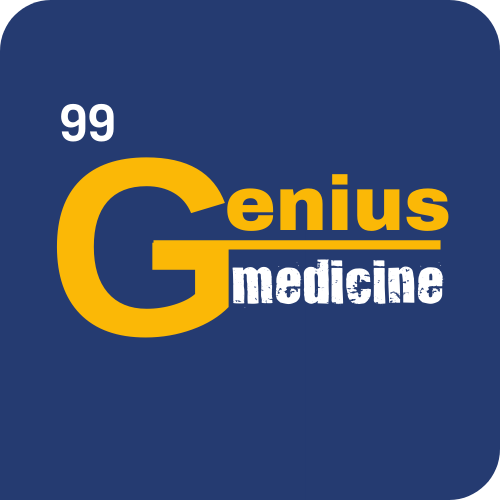In the realm of medical studies, effective memorization is key, and this is where spaced repetition comes into play. It involves revisiting study material at strategic intervals to ensure long-term retention. Alongside, the testing effect, which leverages active recall through targeted questions, further solidifies learning.
For those new to these concepts or looking for a detailed exploration, our previous article delves into the specifics of spaced repetition and the testing effect. It’s an essential read to grasp the fundamentals of these powerful learning techniques ([link to the previous article]).
In this article, we’ll explore how these methodologies are integrated into Genius99, offering an innovative approach to mastering medical studies. Ready to see how? Let’s begin.
Decoding a USMLE Question
The United States Medical Licensing Examination (USMLE) is known for its complex and application-based questions, designed to test a medical student’s ability to apply broad concepts to specific clinical scenarios. Understanding the structure and intent of these questions is crucial for effective preparation. Below is an example of a typical USMLE question. Let’s dissect it to understand the fundamental knowledge required and how it applies to this particular case:
USMLE Example Question:
A 42-year-old nulligravid woman comes to the office because of a 1-year history of increasingly irregular vaginal bleeding and menstrual cramps. Previously, menses occurred at regular 28-day intervals and lasted 3 days with minimal cramping. During the past year, menstrual periods have occurred at 21- to 28-day intervals and lasted 10 to 12 days with increasingly severe pain. Use of acetaminophen and ibuprofen has provided minimal relief. She used an oral contraceptive from the age of 17 years to 40 years, but she discontinued use after she was diagnosed with deep venous thrombosis of the right lower extremity. She has no other history of serious illness and takes no medications. Her mother and sister underwent hysterectomy at the ages of 39 and 43 years, respectively, because of abnormal uterine bleeding. The patient is 163 cm (5 ft 4 in) tall and weighs 75 kg (165 lb); BMI is 28 kg/m2. Vital signs are within normal limits. Physical examination discloses an enlarged, irregularly shaped uterus with nodularity. Which of the following is the most likely cause of the patient’s symptoms?
(A) Benign monoclonal tumors arising from smooth muscle cells
(B) Endometrium growing into the myometrium
(C) Endometrium growing outside the uterus
(D) Failure of functional ovarian cysts to regress after the release of an ovum
(E) Ovarian stromal cells dividing and multiplying rapidly
In the following analysis, we’ll dive into the essential knowledge required to approach this question and demonstrate how such knowledge can be applied effectively in this scenario.
Basic Knowledge Required:
To tackle the USMLE question effectively, a strong foundational understanding is essential. Here’s what you need to know:
- Menstrual Cycle and Abnormalities: Understanding normal menstrual cycle length, duration, and common causes of irregularities.
- Gynecological Pathologies: Knowledge of common gynecological conditions causing irregular bleeding and pain, such as fibroids, endometriosis, and adenomyosis.
- Effects of Oral Contraceptives: Awareness of how long-term use of oral contraceptives can impact menstrual patterns and gynecological health.
- Family History Considerations: Understanding the significance of family history in gynecological diseases.
- Deep Venous Thrombosis (DVT) and Contraception: Knowing the risks associated with oral contraceptive use, especially in the context of DVT.
- Physical Examination Findings: Familiarity with physical exam findings in gynecological conditions, particularly the significance of an enlarged, irregular uterus.
Application in This Case:
Equipped with the necessary knowledge, it’s time to apply what you’ve learned to analyze the patient’s case:
- Irregular and Painful Menstruation: The patient’s symptoms have changed significantly from her baseline, suggesting a pathological process.
- Discontinuation of Oral Contraceptives: The symptoms started after stopping oral contraceptives, indicating a possible link.
- Family History of Hysterectomy for Abnormal Bleeding: Suggests a hereditary component to her condition.
- Physical Exam – Enlarged, Irregular Uterus: This finding is key in narrowing down the diagnosis.
Our Unique Method to Master USMLE
Spot Questions
At the heart of the Genius99 app experience are the spot questions. Engaging with these concise, focused questions through our spaced repetition algorithm is key to your study routine. This approach ensures that you don’t just memorize crucial information, but also become adept at applying it to real-world medical scenarios.
Here are a few examples of spot questions you’ll encounter in Genius99:
What is the average length of a normal menstrual cycle?
A) 14-21 days
B) 21-35 days
C) 28-30 days
D) 35-45 days
Which gynecological condition is commonly associated with heavy menstrual bleeding and an enlarged uterus?
A) Ovarian cyst
B) Uterine fibroids
C) Endometriosis
D) Pelvic inflammatory disease
Long-term use of oral contraceptives can lead to which of the following changes in menstrual patterns after discontinuation?
A) Shorter, lighter periods
B) Longer, heavier periods
C) Immediate return to pre-contraceptive patterns
D) Permanent cessation of menstruation
Which of the following is a recognized risk associated with oral contraceptive use?
A) Reduced risk of ovarian cancer
B) Increased risk of deep venous thrombosis
C) Decreased risk of endometriosis
D) Increased risk of diabetes
An enlarged, irregularly shaped uterus on physical examination is most suggestive of:
A) Ovarian torsion
B) Uterine prolapse
C) Uterine fibroids
D) Cervical cancer
Through repetitive practice of these targeted questions, you’ll not only memorize essential facts but also deepen your understanding of complex medical situations. It’s about building a foundation that enables you to think critically and apply knowledge effectively in a clinical context.
Real-life Cases
In Genius99, we go beyond theoretical knowledge by incorporating real-life medical cases into our learning modules. These cases are designed to mirror the complexities and nuances of actual clinical situations, offering a deeper, more practical understanding of medical concepts. Here are a couple of examples that illustrate how the knowledge you gain can be applied in real-world scenarios, much like what you’d encounter in the USMLE exam:
A 38-year-old nulligravid woman, previously having regular 28-day menstrual cycles, presents with a history of 8 months of menstrual periods occurring at 24- to 26-day intervals, lasting 7 to 9 days with severe cramping. She reports using ibuprofen for minimal relief. There’s no significant medical history except for a brief use of oral contraceptives during her twenties. On examination, she is found to have an enlarged, irregularly shaped uterus. An ultrasound confirms multiple fibroids, leading to a diagnosis of uterine fibroids as the cause of her symptoms.
A 45-year-old woman comes to the clinic complaining of increasingly heavy and painful periods over the last year, previously having had regular cycles with minimal discomfort. She has a family history of her mother undergoing a hysterectomy for similar issues. She has never been on oral contraceptives due to a personal preference. Examination reveals a uniformly enlarged, tender uterus, and subsequent MRI suggests adenomyosis. Her symptoms and family history, along with imaging findings, point towards adenomyosis as the primary cause of her menstrual irregularities.
These cases vividly demonstrate the real-life application of medical knowledge. They show how the details you learn, the patterns you recognize, and the clinical reasoning skills you develop are directly applicable to diagnosing and managing patient cases. This practical approach not only prepares you for the USMLE but also for your future role as a medical professional.
Board-style Questions
The culmination of your learning journey with Genius99 is the board-style questions, designed to emulate the actual USMLE examination format. After engaging with our learning modules, you’ll find that answering these complex questions feels intuitive. Take a look at this example to see how well-prepared you’ll be:
A 39-year-old nulligravid woman presents to the clinic complaining of heavy and prolonged menstrual bleeding for the past 6 months. She reports that her menstrual cycles used to be regular, with minimal discomfort, but have now become quite debilitating, affecting her daily activities. She denies any recent changes in medications or significant medical history. Her mother had a hysterectomy at the age of 41 due to similar issues. On physical examination, the patient’s uterus is noted to be enlarged and nodular. An ultrasound of the pelvis reveals multiple intramural fibroids. Which of the following is the most likely cause of this patient’s menstrual changes and physical examination findings?
(A) Endometrial hyperplasia
(B) Ovarian cysts
(C) Uterine fibroids
(D) Pelvic inflammatory disease
(E) Cervical polyps
At Genius99, we take the guesswork out of your USMLE preparation. You don’t have to piece together a study plan on your own; our app is designed to guide you through the most challenging questions you’re likely to encounter on the exam. Just follow our structured curriculum, and you’ll be well on your way to acing the USMLE.
Conclusion
We’ve explored the unique ways in which Genius99 leverages the powerful concepts of spaced repetition and the testing effect to master the USMLE. By breaking down complex medical knowledge into digestible spot questions, presenting real-life case scenarios, and offering board-style questions, we ensure that every aspect of your learning is covered. This approach not only aids in deep memorization but also in the practical application and understanding of medical concepts – skills essential for any aspiring medical professional.
Genius99 isn’t just about passing exams; it’s about shaping a comprehensive understanding of medicine that stays with you long after you’ve left the classroom. By integrating spaced repetition and retrieval practice into our platform, we’re setting a new standard for medical education.
Curious to see how this innovative approach can transform your USMLE preparation? We invite you to try our demo and experience the Genius99 difference firsthand. Plus, by joining our waitlist, you secure a spot for early access and get 3 months of free access to our full suite of learning tools. Don’t miss this opportunity to elevate your medical studies. Join us at Genius99, where learning meets innovation.




